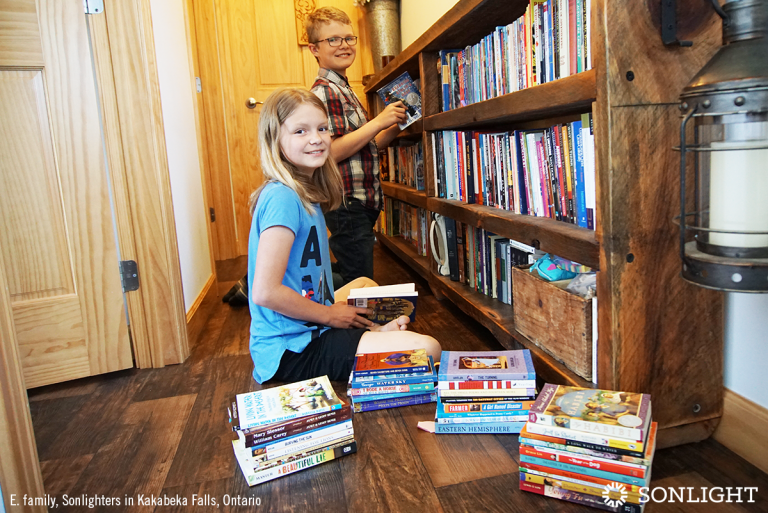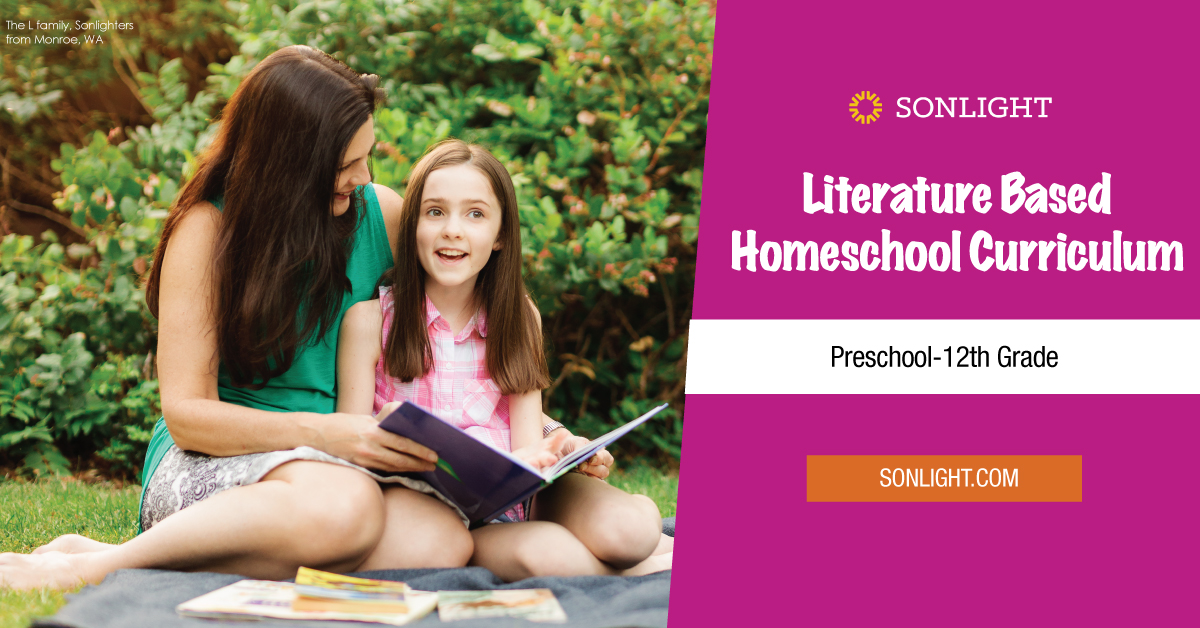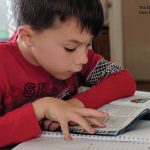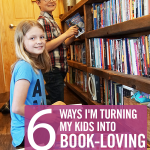
"We are so thankful for all the wonderful books we get to add to our family library each year as we homeschool with Sonlight. Hayden (12) and Sienna (10) are helping put away this year's readers into one of our many bookshelves. We are excited to think of the collection we will have accumulated by the time these two graduate, as we anticipate many more years homeschooling with Sonlight.
— Leila E. of Kakabeka Falls, Ontario
My kids are all heavy readers. In fact, a few of them are known for getting in trouble for staying up too late, reading a good book. I’ve never really had to tell them to read. While I think that reading is probably in their genes, I can look back and pinpoint a few things that we did that helped cultivate that love of reading.
1. Read and Talk to Your Babies
Building good readers begins early, even earlier than you may think. Actually, good literacy skills begin while the child is still in the womb. It’s never too early to begin reading aloud to your child. While it may seem strange, reading aloud during pregnancy is a great way to bond with your little one. Of course, once the child is born, you’ll be able to step up your game.
First, keep reading aloud. I can remember reading aloud from the Psalms during late night feedings. It was almost the only thing that kept me awake! I read picture books to my children before they could even hold up their heads, and some of their very first toys included the virtually indestructible, crinkly books that baby can use for light reading or chewing! Making books a part of your life early on is a great way to begin a love for literacy.
Of course, reading is a no-brainer for encouraging early literacy, but one other important part of literacy development most people don’t think of is speech. This was one of our favorite games to play with our babies: Whatever noise they made, we made right back to them. Every babble and gurgle, we would mirror. As they got older and they began developing a small vocabulary, we would begin “holding conversations” with them. Even if we didn’t have a clue what they were saying, we would nod and speak to them as if it were the most interesting thing we’d ever heard!
2. Read Often
Take advantage of the little moments. Read aloud as often as you are able. Keep a couple of favorite books in the diaper bag or your purse to read during unexpected wait times. If you find yourself without a book, recite nursery rhymes together or see if your child can remember the rhyming words.
Car trips are the perfect opportunity to have conversations or listen to songs or audio books. I used to always keep a stash of picture books in the car for when we traveled. Think of easy ways to sneak books into your everyday routines. And of course, a literature-based curriculum like Sonlight will infuse your day with plenty of great books.
3. Make Up Stories
Another important element of early literacy is creating stories. Now, much of this work happens naturally for children. If you’re a parent, I’m sure your little one has told you a fantastical tale a time or two. Of course, there are ways to encourage this imagination exercise.
- Wordless Books—One of our favorite wordless books is Pancakes for Breakfast by Tomie dePaola. I would explain to my kids that these types of books are wordless and that we get to create the story! I would show them how it’s done, and then they would take a turn, telling a story using the pictures provided.
- Round Robin Storytelling—Another way to create stories is collectively with each person taking a turn. One person starts a story and then tags someone else to take over. Keep going until everyone has had a turn. You’ll be amazed by the tales you spin!
4. Create Space for Reading
As kids get older, you might find that it’s a little more difficult to keep them reading simply because of all their activities. Our solution is to create space for reading in our daily routine. When they are little, we read a book before naptime. Not only was it a good literacy practice, but it provided a cue that it was time for rest. As they got older and began to transition out of naptime, we continued Quiet Time. The kids could stay awake, but they had to stay on their beds and rest while reading a book. That seemed to be a good compromise for everyone.
Now that naptime is a thing of the past around my home, I am finding that my kids still need me to help them create space for reading. By limiting time on screens, we create more time for reading. We also try to gather in the living room in the afternoons for reading. My teenager is finding himself on a different clock now, wanting to stay up later at night and sleep later in the morning, so we have determined that before bedtime is a great space for his reading time.
5. Model the Love of Reading
What the parent does, the children are sure to follow. Making reading a part of your life is a great way to pass on a love for literature to your children. My children have seen me cooking dinner while reading a book. (I can’t say for certain how the dinner turned out on those particular nights!)
I, too, have stayed up far past my bedtime reading, so I tend to be understanding when they do that. We regularly read the newspaper and the Bible. Letting your kids catch you reading is a really important element to developing their own reading habits.
My kids also know without a doubt that I am going to be the most excited person in the room whenever we start a new book together. No one can match my eager anticipation. While they lightheartedly make fun of me for my zest, I know that deep down they are internalizing the role that books play in my life.
6. Make Book Recommendations & Keep a Stock of Great Titles
Books are even part of my love language. I learn my children's reading preferences, and I make book recommendations. We don’t buy new toys often, but my kids know that books are a weakness. If they ask me for a book, chances are good that I’m going to get it for them. They also know that they may come home to a new book, waiting on their bed—just because I thought they might like it.
I’ve also been known to restock the living room book basket with a selection of carefully chosen stories, at least two for each child. They each have a book basket beside their beds as well. Making books accessible is a huge key to instilling a love of reading. This can be accomplished in a few different ways. While we choose to build our home library, making weekly trips to your local public library or organizing a book swap can provide the same benefits.
Building readers may sound like an impossible task, but it’s really more about making books a part of your family lifestyle than anything else. Finding small ways to encourage reading can translate to big payoffs in literacy development. And if you read this blog post, and you think it’s too late, don’t worry. It’s never too late to encourage reading.
Sonlight is an entire curriculum built around the love of great books. Learn the most enjoyable way. Experience a Sonlight education. Get started here.









